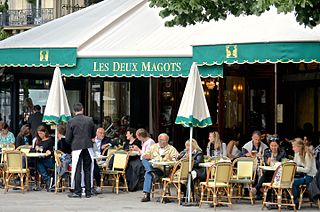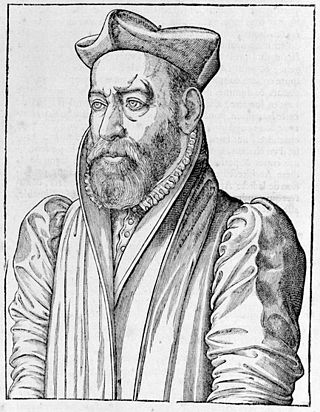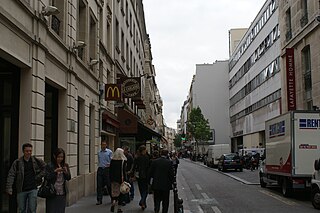Related Research Articles

The 6th arrondissement of Paris is one of the 20 arrondissements of the capital city of France. In spoken French, it is referred to as le sixième.

Philibert de l'Orme was a French architect and writer, and one of the great masters of French Renaissance architecture. His surname is also written De l'Orme, de L'Orme, or Delorme.

The Church of Saint-Sulpice is a Catholic church in Paris, France, on the east side of Place Saint-Sulpice, in the Latin Quarter of the 6th arrondissement. Only slightly smaller than Notre-Dame and Saint-Eustache, it is the third largest church in the city. It is dedicated to Sulpitius the Pious. Construction of the present building, the second on the site, began in 1646. During the 18th century, an elaborate gnomon, the Gnomon of Saint-Sulpice, was constructed in the church.

Louis Tullius Joachim Visconti was an Italian-born French architect and designer.

The rue de Provence is a street located in the 8th and 9th Arrondissements of Paris. It begins at the rue du Faubourg Montmartre and ends at the rue de Rome. Only the short part of the street between rue du Havre and rue de Rome is in the 8th arrondissement.

The Fontaine de l'Abbaye de Saint-Germain-des-Prés is a fountain constructed in 1715-1717, at the end of the reign of King Louis XIV and the beginning of the reign of Louis XV, to provide drinking water in the neighborhood near the church of Saint Germain-des-Prés, in the 6th arrondissement of Paris. It was originally located at the corner of the Rue Sainte-Marguerite and Rue Childebert. The fountain mechanics were designed by Jean Beausire, the chief of public works and fountain-maker for Louis XIV, who built more than twenty fountains in Paris between 1684 and 1740. The architect was Victor-Thierry Dailly, who in 1715 was commissioned to build a group of houses and the fountain around the parvis of the Church of Saint-Germain-des-Pres.

Rue Bonaparte is a street in the 6th arrondissement of Paris. It spans the Quai Voltaire/Quai Malaquais to the Jardin du Luxembourg, crossing the Place Saint-Germain-des-Prés and the place Saint-Sulpice and has housed many of France's most famous names and institutions as well as other well-known figures from abroad. The street runs through the heart of the fashionable Left Bank and is characterised by a number of 'hôtels particuliers' and elegant apartment buildings as well as being bounded by the river at one end and the park at the other. With fifteen buildings or monuments classified as Monument Historique, it has more such listed sites than any other street in the 6th arrondissement.

François d'Orbay was a French draughtsman and architect who worked closely with Louis Le Vau and Jules Hardouin Mansart.
Pierre Thierry (1604–1665) was the founder of the Thierry dynasty of organ builders of Paris, France.

The Rue Saint-Lazare is a street in the 8th and 9th arrondissements of Paris, France. It starts at 9 Rue Bourdaloue and 1 Rue Notre-Dame-de-Lorette, and ends at Place Gabriel-Péri and Rue de Rome.

François Le Vau was a French architect and a founding member of the Académie Royale d'Architecture. He is also known for being the youngest brother of the more famous French architect, Louis Le Vau.

Pentemont Abbey is a set of 18th and 19th-century buildings at the corner of Rue de Grenelle and Rue de Bellechasse in the 7th arrondissement of Paris. The complex had originally been a Cistercian monastery of nuns. The abbey was founded near Beauvais in 1217 and moved to its current site in Paris in 1672 at the behest of King Louis XIV. A reconstruction of the abbey was initiated in 1745 by the Abbess Marie-Catherine Béthisy de Mézières and work was completed in 1783. In the late 18th century, the abbey was one of the most prestigious educational institutions in Paris for daughters of the elite, including two of Thomas Jefferson's. The abbey also provided rooms for ladies of good standing who were in search of rest, including Joséphine de Beauharnais when the case of her separation from her first husband was heard.

Louis Jules César "Louis-Jules" Bouchot was a 19th-century French architect responsible in particular for the construction of the Nice and Milan railway stations.
Claude Vellefaux was a 16th/17th-century French architect, who had the Hôpital Saint-Louis built in 1611 at the request of Henry IV of France.
Pierre Levesville was a 17th-century French architect.
Charles Chamois was a 17th-century French architect from Paris.
Jean-Marie Pérouse de Montclos is a French architectural historian.

Hôtel de Guénégaud or Hôtel de Guénégaud-des-Brosses is a 17th-century hôtel particulier, or large townhouse, in Paris.
Pierre I Biard l'Aîné (1559 – 17 September 1609) was a French sculptor and architect, part of a lineage of prominent sculptors.
References
- ↑ Georges Brunel 1994, p. 495 ("Saint-Sulpice"), in Le Guide du patrimoine de Paris, edited by Jean-Marie Pérouse de Montclos. Oudin 1994, p. 136, gives "circa 1654."
- 1 2 3 4 Jean-Pierre Babelon, Demeures parisiennes sous Henri IV et Louis XIII, Paris, Éditions Hazan, 1991, ISBN 9782850252518, p. 256.
- ↑ Histoire pénitentiaire et justice militaire : l’Abbaye, maison d’arrêt et de discipline militaire à Saint-Germain-des-Prés.
- ↑ L'Hôpital Laennec 400 ans d'histoire de la médecine on Pour la Science
- ↑ Pérouse de Montclos 1995, p. 514.
- ↑ Jeanne Pronteau, Paris, Imprimerie nationale, 1974 ISBN 978-2-600-05333-4, p. 547. Read online.
- ↑ Georges Brunel 1994, p. 495 ("Saint-Sulpice"), in Pérouse de Montclos 1995, p. 495.